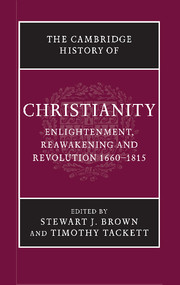Book contents
- Frontmatter
- Introduction
- PART I CHURCH, STATE, AND SOCIETY IN THE EUROPEAN WORLD, 1660–1780
- PART II CHRISTIAN LIFE IN THE EUROPEAN WORLD, 1660–1780
- 5 The Catholic clergy in Europe
- 6 The Protestant clergies in the European world
- 7 Reaching audiences: Sermons and oratory in Europe
- 8 Christian education
- 9 Christianity and gender
- 10 Popular religion
- 11 Jewish–Christian relations
- 12 Architecture and Christianity
- PART III MOVEMENTS AND CHALLENGES
- PART IV CHRISTIAN DEVELOPMENTS IN THE NON-EUROPEAN WORLD
- PART V REVOLUTION AND THE CHRISTIAN WORLD
- Chronology
- Bibliography
- Index
- References
12 - Architecture and Christianity
from PART II - CHRISTIAN LIFE IN THE EUROPEAN WORLD, 1660–1780
Published online by Cambridge University Press: 28 March 2008
- Frontmatter
- Introduction
- PART I CHURCH, STATE, AND SOCIETY IN THE EUROPEAN WORLD, 1660–1780
- PART II CHRISTIAN LIFE IN THE EUROPEAN WORLD, 1660–1780
- 5 The Catholic clergy in Europe
- 6 The Protestant clergies in the European world
- 7 Reaching audiences: Sermons and oratory in Europe
- 8 Christian education
- 9 Christianity and gender
- 10 Popular religion
- 11 Jewish–Christian relations
- 12 Architecture and Christianity
- PART III MOVEMENTS AND CHALLENGES
- PART IV CHRISTIAN DEVELOPMENTS IN THE NON-EUROPEAN WORLD
- PART V REVOLUTION AND THE CHRISTIAN WORLD
- Chronology
- Bibliography
- Index
- References
Summary
A little-known body of architecture: an overview
In their studies of early modern architecture, art historians have not been unduly concerned with questions of quantity. Yet it is clear that the shear number of religious constructions built in Europe after the middle of the sixteenth century was considerable, and that with the exception of urban and rural housing, there was probably no area of architectural activity more dynamic than the construction of places of worship. During much of this period Europe came to resemble one immense church construction site. Yet this expansion cannot be explained solely by the growth or mobility of the population, nor by the earlier destruction of churches through acts of violence, nor even by the deterioration of the stock of existing medieval churches. It was due rather to the state of religion which emerged from the Reformation. On the one hand, new denominations had particular liturgical requirements that meant they were no longer content to adapt the churches of the Middle Ages: they had to build new ones. And on the other, the Catholic Reformation’s assimilation of elements of both humanism and the Protestant Reformation led to a reappraisal of needs for liturgy, architecture, and decor. Moreover, Catholic renewal led to new forms of spirituality and pastoral activities and subsequently to the founding of numerous religious orders, all of which required the construction of chapels for their communities.
- Type
- Chapter
- Information
- The Cambridge History of Christianity , pp. 226 - 248Publisher: Cambridge University PressPrint publication year: 2006



